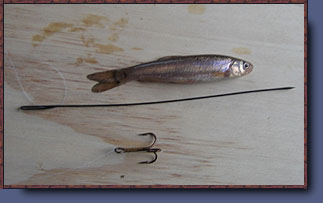Lake trout are caught on open water mainly by trolling at depths of 20 to 60 feet. After ice-out and while water is still cold in May, lake trout tend to be at higher levels retreating to deeper parts of the lakes during the warm summer months. You can use a fish-finder to determine the depth range at which most lake trout are situated. In some instances, the more aggressive trout are within a narrow depth range and it is important to get your presentation to this depth.
The spinner set needs to be fairly heavily weighted so that it does not float near surface behind the boat and must have a large flat anti-rotation plate to prevent twisting of your line due to the rotational action of the spinners. The spinners are normally silver or gold and need to have a snap swivel at the bottom end to which you attach a hook on about a one-foot monofilament lead.
On the one-foot lead, be sure to use line that is somewhat lighter than that of the main fishing line. In this way, if you snag the hook on-bottom you may loose only the hook and not the expensive cowbells.
Moderate-sized minnows (2 to 3 inches long) are a good bait to put on the hook. One baiting option is to use a special needle (shown in photo below) to drag the leader forward through the intestinal area of the minnow until the body of the minnow is situated within the barbs of the hook. Make up several of these baited hooks with leads and have them ready for quick access if you get some action!
|
Getting your bait to the proper depth is important. The traditional technique of gauging depth is to observe your rig close-up beside the boat and noting the angle at which the apparatus descends into the water at a slow and consistent trolling speed.
|

|
You can count off the length of line that you let out as a way of gauging the depth at which your rig is traveling. Other techniques include using a downrigger or a special Y-shaped swivel with your bait on one prong and a heavy weight on a 2-foot lead on another prong. You can allow the weight to drag bottom at the appropriate depth and the bait stays a little above bottom.
If you don't know much about the structure of the lake, try trolling about 100 feet from shore along sections of rocky or boulder strewn and steeply sloped shoreline. Lake trout are often caught in areas of bouldery lake-bottom situated off points of land or adjacent to gravely shoals. If you get a strike, loop back and pass over the area again or try jigging at this hot spot.